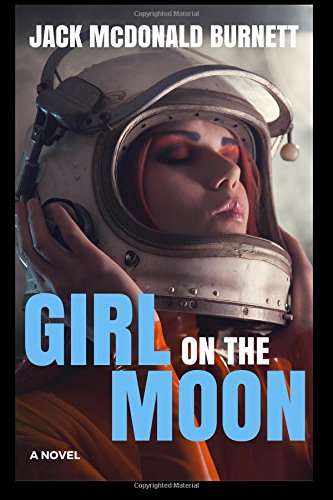Review: Girl on the Moon by Jack McDonald Burnett
Comparison of Burnett's Girl on the Moon with Andy Weir's The Martian is inevitable, so I'll just get it out of the way at the start. Both novels open with a disaster that strands a single person on a distant globe. And both were first "independently" published, independently, that is, of any traditional publishing house.
That's it, full stop. In Girl Conn Garrow's world, the Mars trip ended in complete disaster, killing all the astronauts involved, and NASA hasn't been back. No man has set foot on the moon since Gene Cernan and Harrison Schmidt left in 1972. And no woman has ever been on the moon.
The last person who tried, Peo Haskell, CEO of Dyna-Tech, was turned back on the brink of landing her privately-owned lander. Conn's own dream of going to space, fueled by her admiration of Peo Haskell and by witnessing a night of mysterious lights on the moon that was visible from Earth when she was a child, was derailed when she was diagnosed with bipolar disorder. Disqualified by NASA because she is permanently on medication to treat her condition, she redirects her ambition to engineering. If she cannot be an astronaut, she can still make it possible for others to go to space in her stead.
At school, Conn connects with her idol Peo, and begins working for her to set up a private-enterprise trip to Saturn. An unusual video sent in secret to Peo holds a cryptic puzzle that Conn helps solve. They learn it is an invitation from the aliens who lit the moon that long-ago night, offering to meet near the Apollo 15 lander. The Chinese will be sending their own separate mission in response. Not to be out-done, NASA immediately sets up a rival moon-shot as a joint effort with the European Space Agency.
NASA wasn’t letting the moon get away from them again.
Dyna-Tech, stretched thin to support the four-year trip to Saturn, scrambles to set up its own mission to the Moon. Solving one problem after another, Conn is intimately connected with both space shots, telling herself that this is as close as she could possibly come to her dream. Because of the novel's opening scene, we know better; Conn will be the commander of the two-person moon-shot that will put her on the surface in time to meet the aliens. In their privately-funded launch, Peo Haskell and Dyna-Tech can override the restrictions NASA uses for astronaut selection.
"I wonder how many kids like you NASA misses out on because there are no Rite-Aids in space ... "Nope, sorry, you're lactose intolerant, we can't train you."
Once you get past the largest unreal plot-point, ETs with YouTube accounts, the story seems realistic. It is further given reality by countless details that make sense in an 18-year distant future. Yet what feels even more real than the slightly-advanced tech are the emotional interactions, the jealousy and envy and spite, the admiration and aspiration and generosity, the fear and delight, displayed by all these people, human and alien alike. New authors (and sometimes veteran writers as well) can make the mistake of painting characters as either black or white. Burnett dodges this bullet; even Conn is a frustratingly messy mix of emotional reactions.
Conn must battle her own shortcomings and biases, the petty and major problems of any large commercial effort, her own government and the rival governments of those who meet the aliens on the moon, and the aliens themselves. Are these visitors to the Solar System evil, bent on conquering humanity by tempting them with alien tech, as the anti-science evangelist Bowman insists? Are they simply guilty of preferring to work with the Chinese and the Russians, as the US government accuses?
Or are they interstellar con-artists, looking for the equivalent of a Manhattan bead exchange?
Conn and her friends have a lot of mysteries to solve—not least of which is what the aliens want from our moon. Their struggle to find those solutions is exciting, and the suspense makes this novel a quick read. That they accomplish it all in the context of capitalist free enterprise is delightful.
I'll be waiting with bated breath for the next Girl (on Mars?) from Burnett.
Liner Notes:
- The publisher is Kindle Press, thanks to a successful Kindle Scout campaign. Because I was one of many who nominated this novel, I got a copy for free.
- An excellent map of the Apollo 15 landing site is available online from the Smithsonian's National Air and Space Museum.
- Conn receives congratulations for being the first woman on the moon from a female US president named Clinton. The date is 2034. Chelsea?

No comments:
Post a Comment